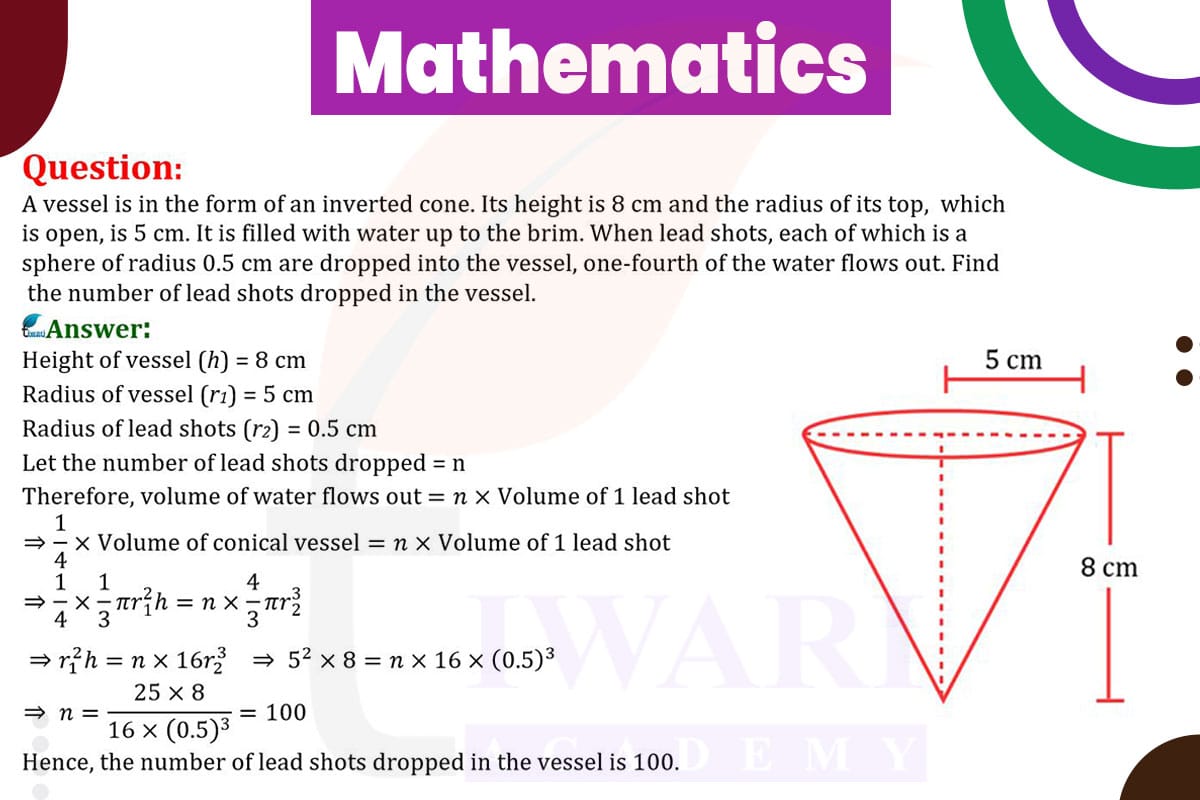To find the number of lead shots dropped into the vessel, we first calculate the volume of water that flows out, which is one-fourth of the vessel’s total volume. Then, we determine the volume of one lead shot and use this to find the number of shots.
The vessel is an inverted cone with a height of 8 cm and a radius of 5 cm. The volume of a cone is (1/3)πr²h. So, the total volume is (1/3)π×5²×8.
One-fourth of this volume is the volume of water that overflows, which is equal to the total volume of the lead shots. The volume of one lead shot, which is a sphere with a radius of 0.5 cm, is (4/3)πr³ = (4/3)π×0.5³.
Dividing the total volume of overflowed water by the volume of one lead shot gives the number of lead shots dropped into the vessel.

Let’s discuss in detail
Volume Displacement in a Conical Vessel
The problem at hand involves understanding the concept of volume displacement in a conical vessel. This is a classic application of the principles of geometry and physics, particularly the concept of Archimedes’ principle, which states that the volume of fluid displaced is equal to the volume of the object submerged. In this scenario, an inverted conical vessel with a height of 8 cm and a radius of 5 cm is filled to the brim with water. When lead shots, each being a small sphere with a radius of 0.5 cm, are dropped into the vessel, one-fourth of the water overflows. The goal is to determine the number of lead shots added to the vessel.
Calculating the Volume of the Conical Vessel
The first step is to calculate the total volume of the conical vessel. The formula for the volume of a cone is (1/3)πr²h, where r is the radius and h is the height. For our vessel, with a radius of 5 cm and a height of 8 cm, the total volume is (1/3)π×5²×8 cubic centimeters. This volume represents the maximum amount of water the vessel can hold before any lead shots are added.
Understanding the Volume Displacement by Lead Shots
When the lead shots are dropped into the vessel, they displace a certain volume of water, causing it to overflow. Since one-fourth of the water overflows, the volume of water displaced by the lead shots is equal to one-fourth of the total volume of the vessel. This relationship between the displaced water and the volume of the lead shots is key to solving the problem, as it allows us to equate the volume of displaced water to the combined volume of the lead shots.
Calculating the Volume of a Single Lead Shot
Each lead shot is a sphere with a radius of 0.5 cm. The volume of a sphere is given by (4/3)πr³. Therefore, the volume of one lead shot is (4/3)×0.5³ cubic centimeters. This calculation is crucial as it gives us the volume of a single lead shot, which will be used to determine how many such shots can fit into the volume of water that was displaced.
Determining the Number of Lead Shots
To find the number of lead shots dropped into the vessel, we divide the total volume of water displaced (one-fourth of the vessel’s volume) by the volume of a single lead shot. This division gives us the number of lead shots that would collectively displace an amount of water equal to one-fourth of the vessel’s total volume. This calculation is a direct application of the principle of volume displacement and provides the solution to our problem.
Practical Implications of Geometric Calculations
In conclusion, this problem illustrates the practical application of geometric principles in understanding real-world phenomena like volume displacement. It not only reinforces the understanding of how to calculate the volumes of different shapes but also highlights the importance of these calculations in understanding physical phenomena. Such problems bridge the gap between theoretical mathematics and practical physics, showcasing the relevance and application of mathematical concepts in everyday life. This exercise is a testament to the importance of geometry in solving practical problems and understanding the world around us.
Discuss this question in detail or visit to Class 10 Maths Chapter 12 for all questions.
Questions of 10th Maths Exercise 12.2 in Detail

